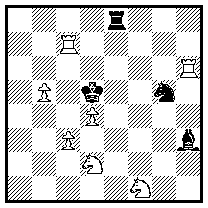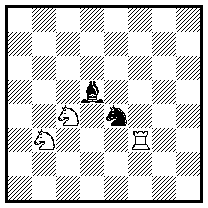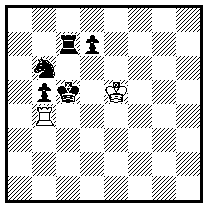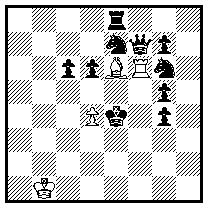8th World Chess Composing Tournament of the FIDE
Questions and Answers 4
Section A
a) Is there any example on how could a random move be an interference
(the last mentioned case)? Does it mean the correction move must also be another
interference of the same black line, as we got used to see in the Correction
of the third degree?Reply: See example below. The correction-move must interfere with the same
black line, but the resulting mate does not have to use this interference.Sketch:
#2
Threat: 2.Rc5#
1…Se4 (a random interference) 2.Se3#
1…Se6! (a correction) 2.Rd7#b) Some named themes in their basic forms (Vladimirov, Banny, Dombrovskis,
Hannelius, etc.) ask for two thematic refutations. Does it mean that random
move (1…F~) in 8. WCCT should be treated as an absolutely normal (not as
inferior, as usually) refutation?Reply: The theme does not specify the nature of the refutation. It is the
judges’ duty to consider if a double/multiple/random-move refutation is justified
within a given problem.c) Some problemists accept Black correction only if there are two or more
moves (not only one!) representing random move (in the common definition of
taking a piece away from some field). Should only one possible move in this
case be treated as an absolutely normal random move, not as inferior or less
thematic one?Reply: It is allowed for a single move to represent a random move. It is
the judges’ duty to assess its necessity within a given problem or whether
it creates any disturbance.
Section D
An important notice:
Your attention is required for a change in interpretation concerning the Studies
theme. This change is considered necessary to remove the confusion created
by the old interpretation. Apologies for any inconvenience this might cause.
According to the new interpretation, if an attacked
piece is also guarded, the subsequent elimination of this guard (by interference,
capture, withdrawal, pin, etc.) cannot by itself be considered thematic.
Hopefully, this will simplify things and make them more congruent with intuitive
understanding of the theme.
Some of the former answers to a number of questions are adjusted accordingly.
To be updated, please visit again all Questions and Answers
regarding theme D on the PCCC website.a) In the position:
White: Sb3 Sc4 Rf3; Black: Bd5 Se4 – is the sequence 1…Sd6 2.Se3 thematic?
Yes, it is thematic. A discovered attack (1…Sd6, exposing Rf3 to an attack
from Bd5) and a discovered sacrifice (2.Se3, exposing Sb3 to an attack from
Bd5) are allowed.b) In a study with two variations or a main solution and a try, is it
enough for the thematic requirements to occur on any of these phases?
Reply: For the study to be thematic, at least one line of the actual solution
must show the theme.
Section E
a) Is it acceptable here H#2.5 besides H#3? The idea can be shown even
in H#2, so a H#2.5 will have no impact on the thematic requirement.
Reply: H#2.5 is not allowed.b) If the black thematic piece moves more than once in a solution, the
requirement is fulfilled, but the strategy may have nothing to do with the
samples given. What is the intention here: to keep the requirement regardless
of what strategy may result, or to keep the strategic spirit of the given
examples, even if the requirement doesn’t ask for it?
Sample illustration:
H#3 (2+5)
Ke5 Rb4 – Kc5 Rc7 Sb6 Pb5 d7
1.Ra7 Rd4 2.Ra4 R:d7 3.Rb4 Rc7
Reply: As long as the composer fulfills the theme requirement, he is free
to use whatever strategy he chooses. The example is a legitimate rendering
of the theme.c) Is a mate with double check allowed?
Reply: No, it isn’t.d) Is capturing on the mating move allowed?
Reply: Yes, it is allowed.e) Is it allowed for the same or other black piece to enter the vacated
square? For example, is the following problem thematic?J.-M. Loustau & J. Rotenberg
Prize, diagrammes 1992
h#3 (4+10)
White: Kb1 Rf6 Be6 Pd4
Black: Ke4 Qf7 Re8 Se7g6 Pg7c6d6g5g4
1.Qf8 Bg8 2.Qf7 Rf4+ 3.Kd5 Bxf7#
1.Qg8 Rf8 2.Qf7 Bd5+ 3.Kf5 Rxf7#
Reply: Yes, it is allowed. The example is thematic.
Section F
Some problemists consider black dual in mating move as a serious weakness;
others accept it as normal in S#. Do judges have right to lower their mark
more than 0,5 points for such a subjective reason?
Reply: The so called "black dual" on the mating move SHOULD NOT automatically
be considered a weakness. A "black dual" on the mating move might represent
an interesting variety, like any variation in Black’s play in reply to a white
move. It is the judges’ duty to evaluate in each particular case if (and to
what extent) such a "black dual" adds to, decreases from, or has no influence
on the problem’s value.
Section G
What are the minimal thematic requirements for the problem (or is it enough
to have the theme in a single by-variation of an insignificant phase)?
Reply: "Clash of rebirth" is the minimum requirement. Nothing forbids the
occurrence of the theme in "a single by-variation of an insignificant phase",
but there is no guarantee for the result…
Invitation
| Introduction by the WCCT Subcommittee
| Themes | Rules
| All Questions and Answers | List
of registrations









